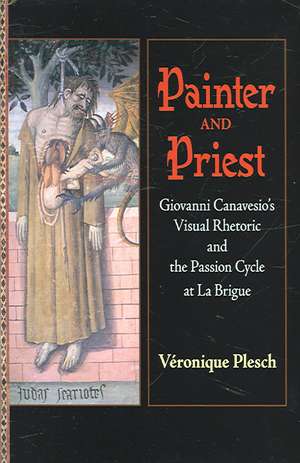Painter and Priest – Giovanni Canavesio`s Visual Rhetoric and the Passion Cycle at La Brigue
Autor Véronique Pleschen Limba Engleză Hardback – 29 iun 2006
Preț: 383.93 lei
Nou
Puncte Express: 576
Preț estimativ în valută:
73.46€ • 76.98$ • 60.73£
73.46€ • 76.98$ • 60.73£
Carte indisponibilă temporar
Doresc să fiu notificat când acest titlu va fi disponibil:
Se trimite...
Preluare comenzi: 021 569.72.76
Specificații
ISBN-13: 9780268038885
ISBN-10: 0268038880
Pagini: 488
Ilustrații: 154 color & b&w
Dimensiuni: 178 x 254 x 27 mm
Greutate: 1.27 kg
Ediția:1
Editura: MR – University of Notre Dame Press
ISBN-10: 0268038880
Pagini: 488
Ilustrații: 154 color & b&w
Dimensiuni: 178 x 254 x 27 mm
Greutate: 1.27 kg
Ediția:1
Editura: MR – University of Notre Dame Press
Recenzii
“With exhaustive descriptions and analyses, the author considers this little-studied region and artist, his sermonic rhetoric, and interwoven pictorial sources. According to the author, Canavesio drew upon his experience as a priest to manipulate form and content, rhetorically emphasizing confession, repentance, and the Good Death . . . this study remains a thorough, highly organized, and well-observed contribution to the study of this Piedmontese artist.” —Renaissance Quarterly(2007)
“Densely bound and packed with information, the study considers the fifteenth-century pictorial Passion cycle from the pilgrimage sanctuary at Notre-Dame des Fontaines in La Brigue; the twenty-five paintings that make up the cycle are examined in their rich (and sometimes gory) detail. . . . This book is an engaging case study and achieves its aim of establishing this cycle as worthy of further study by art historians and historians alike.” —Religion and the Arts, 13[3], 2009
“Plesch [places] Canavesio and his cycle within wider contexts of the production and consumption of religious art and the nature of devotion in an early modern rural Alpine community. The work is recommended for acquisition by university libraries and will also be helpful to undergraduates.” —Fifteenth Century Studies34 (2009)
Notă biografică
VÉRONIQUE PLESCH is associate professor and chair of the Department of Art at Colby College in Waterville, Maine.
Descriere
Giovanni Canavesio, a Piedmontese artist-priest active in the last decades of the fifteenth century in the southern Alps, left behind a significant body of work, including pictorial cycles and altarpieces. This book is an in-depth analysis of his most ambitious cycle on the Passion of Christ, completed in 1492, on the walls of the pilgrimage sanctuary of Notre-Dame des Fontaines outside the French town of La Brigue.
Plesch's primary aim is to understand the cycle's complex and multi-layered meaning. She analyzes the subject matter of the scenes, the significance of their order, how the pictorial and graphic sources were adapted, and the range of formal and visual means used to convey content. Plesch also places Canavesio and his pictorial cycle within wider contexts of the production and consumption of religious art and the nature of devotion in an early modern rural Alpine community.
The two facets of Canavesio's life and work—that of artist and that of priest—are also discussed. Plesch argues that the religious messages conveyed by the cycle scenes, as well as the strategies used by the artist to convey meaning and to structure the viewer's experience, were indeed informed by his training as a priest. Canavesio's approach to the definition of meaning, as well as his pictorial strategies, are considered in the context of the medieval art of preaching, an art whose rules derived from those of rhetoric. By also placing the cycle within the larger universe of late medieval religious devotion, Plesch connects Canavesio's work not only with preaching but with devotional meditation and religious theater as well.
"This exemplary interdisciplinary book is an engagingly written and thorough study of a very interesting cycle of late medieval wall paintings." —Pamela Sheingorn, CUNY Graduate Center, New York
